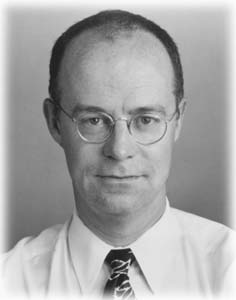![[MetroActive Arts]](/arts/gifs/art468.gif)
![[MetroActive Arts]](/arts/gifs/art468.gif)
[ Arts Index | SF Metropolitan | MetroActive Central | Archives ]
Taking the Helm
John Killacky steps up to head the Yerba Buena Center for the Arts
By Kathryn Roszak
After decades of controversy and a troubled birth, arts watchers wonder: Will the Center for the Arts at Yerba Buena Gardens finally take flight under new leadership?.
The Center certainly needs a strong guiding hand. Since opening in 1993, mid-sized arts groups such as New Century Chamber Orchestra, Lines Contemporary Ballet, ODC/SF and others now call the Center home. Recently, priorities have shifted because of budget cuts for the arts. Many groups must now create co-presentation deals or rent the center's facilities.
Enter John Killacky, who comes to San Francisco with an impressive background as curator of performing arts for the prestigious Walker Arts Center in Minneapolis. Intelligent and assured, the 44-year-old Killacky brings to San Francisco a superb knowledge of how to run a multidisciplinary arts institution. He takes on the job following his recent health crisis--surgery for a benign spine that tumor threatened him with paralysis. "It has been an amazing process with many gifts," he says of the experience. "I have had a fantastic recovery. It clarifies your values in life."
Killacky, who will manage a $5.5 million budget here, ran a $1 million budget at the Walker Arts Center, presenting over 100 performances annually of dance, theater, music and performance art. He describes his style as "entrepreneurial, so the center can get to the next millennium. I am financially conservative."
He is clearly ecstatic about his new appointment in San Francisco and has readily grasped the challenges. "This is the right place and the right moment in San Francisco," Killacky says. "There has been a lot of work done in creating 'a cultural corridor.' The city is unique in that respect.
"The city's demographics are also unique," he continues. "It's a culturally pluralistic, very open city, not just tolerating difference but actively celebrating it."
When asked to cite his achievements at the Walker Arts Center, Killacky replies, "I am most proud of the mixture [we achieved]. There was a real range of work: opera, symphony, and performance art work for audiences of 100 to 4,800. We presented Karen Finley and Kabuki Theatre, and we helped commission San Francisco choreographer Brenda Way's production of Western Women."
Killacky is probably best known for work which he describes with a wry smile as "transgressive. Beauty is something we all need, but nightmares are essential." Killacky may be referring to Law of Remains, a Walker-sponsored theater piece by HIV-positive artist Reza Abdoh dealing with the theme of mass murder.
Cindy Gehrig, president of the Jerome Foundation in Minneapolis, says, "It's hard to watch. It comes out of a long tradition of art that is violent and assaultive."
Killacky has also passionately championed artists who have been attacked by Sen. Jesse Helms and other critics of the NEA. Killacky, who has served on NEA review panels, has sharply criticized the NEA for declining grants to artists whose work is gay-identified or directly sexual in content. His panel position was "nonrenewed" by the NEA, but Killacky fought back. "I remain 100 percent committed to the aesthetics of individual artists. They are crucial, essential to have in society. My job is in service to artists, not to institutions or art forms."
What Killacky does at the Center for the Arts will undoubtedly continue to reflect his fierce advocacy, but he promises to include other points of focus as well. He is quick to say that he is also interested in "lyrical work."
"The Bay Area is musically very rich with groups like the Kronos Quartet," he says, proceeding with care in his new community. "I walk slowly and I respect the ground I walk on. It would be paternalistic of me to tell artists what to do."
Perhaps this attention to the creative process springs from Killacky's status as a practicing artist in his own right. He's a widely respected independent filmmaker whose films have been screened locally at the Pacific Film archives and the International Gay and Lesbian Film Festival. "My work is making opportunities for other artists," Killacky says of his dual existence. "My avocation is to work on my art."
Currently the Center is housing the popular Hall of Fame Hall of Fame exhibit, which echoes the success of the previous sell-out Star Wars show in its mass appeal. "It's good that populist art is part of the picture," says Killacky, unapologetic about the pop culture nature of the two shows. "We can house the intersections of 'high' art and 'low' art, presenting the obscure and the accessible in the same season."
These programming decisions represent Killacky's larger vision for the Center for the Arts. Because of its accessible location and its broad range of programming, the center has probably the best chance of being a nonelitist cultural nexus. "The community took a leap of faith to build this place," Killacky says. "This is a chance to realize the promises."
This page was designed and created by the Boulevards team.

Meet the New Boss: John Killacky tries to bring some of the Vision Thing to the Center for the Arts.
From the April 1997 issue of the Metropolitan
Copyright © 1997 Metropolitan, Inc.